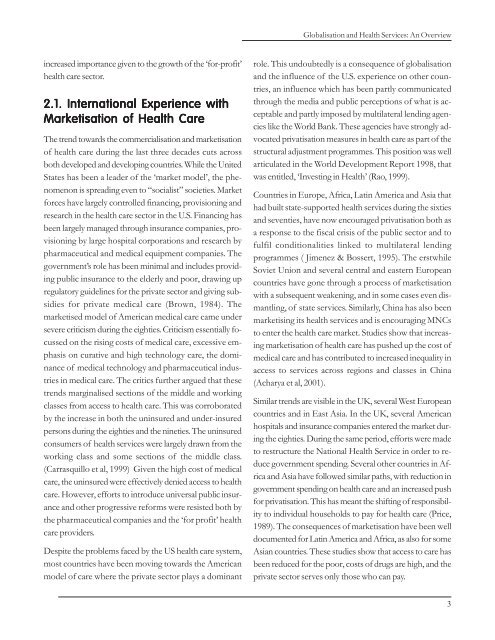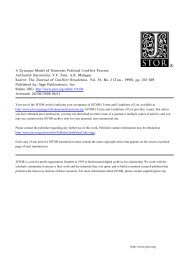Privatisation of Health Care in India - Indian Institute of Public ...
Privatisation of Health Care in India - Indian Institute of Public ...
Privatisation of Health Care in India - Indian Institute of Public ...
- No tags were found...
Create successful ePaper yourself
Turn your PDF publications into a flip-book with our unique Google optimized e-Paper software.
Globalisation and <strong>Health</strong> Services: An Overview<strong>in</strong>creased importance given to the growth <strong>of</strong> the ‘for-pr<strong>of</strong>it’health care sector.2.1. International Experience withMarketisation <strong>of</strong> <strong>Health</strong> <strong>Care</strong>The trend towards the commercialisation and marketisation<strong>of</strong> health care dur<strong>in</strong>g the last three decades cuts acrossboth developed and develop<strong>in</strong>g countries. While the UnitedStates has been a leader <strong>of</strong> the ‘market model’, the phenomenonis spread<strong>in</strong>g even to “socialist” societies. Marketforces have largely controlled f<strong>in</strong>anc<strong>in</strong>g, provision<strong>in</strong>g andresearch <strong>in</strong> the health care sector <strong>in</strong> the U.S. F<strong>in</strong>anc<strong>in</strong>g hasbeen largely managed through <strong>in</strong>surance companies, provision<strong>in</strong>gby large hospital corporations and research bypharmaceutical and medical equipment companies. Thegovernment’s role has been m<strong>in</strong>imal and <strong>in</strong>cludes provid<strong>in</strong>gpublic <strong>in</strong>surance to the elderly and poor, draw<strong>in</strong>g upregulatory guidel<strong>in</strong>es for the private sector and giv<strong>in</strong>g subsidiesfor private medical care (Brown, 1984). Themarketised model <strong>of</strong> American medical care came undersevere criticism dur<strong>in</strong>g the eighties. Criticism essentially focussedon the ris<strong>in</strong>g costs <strong>of</strong> medical care, excessive emphasison curative and high technology care, the dom<strong>in</strong>ance<strong>of</strong> medical technology and pharmaceutical <strong>in</strong>dustries<strong>in</strong> medical care. The critics further argued that thesetrends marg<strong>in</strong>alised sections <strong>of</strong> the middle and work<strong>in</strong>gclasses from access to health care. This was corroboratedby the <strong>in</strong>crease <strong>in</strong> both the un<strong>in</strong>sured and under-<strong>in</strong>suredpersons dur<strong>in</strong>g the eighties and the n<strong>in</strong>eties. The un<strong>in</strong>suredconsumers <strong>of</strong> health services were largely drawn from thework<strong>in</strong>g class and some sections <strong>of</strong> the middle class.(Carrasquillo et al, 1999) Given the high cost <strong>of</strong> medicalcare, the un<strong>in</strong>sured were effectively denied access to healthcare. However, efforts to <strong>in</strong>troduce universal public <strong>in</strong>suranceand other progressive reforms were resisted both bythe pharmaceutical companies and the ‘for pr<strong>of</strong>it’ healthcare providers.Despite the problems faced by the US health care system,most countries have been mov<strong>in</strong>g towards the Americanmodel <strong>of</strong> care where the private sector plays a dom<strong>in</strong>antrole. This undoubtedly is a consequence <strong>of</strong> globalisationand the <strong>in</strong>fluence <strong>of</strong> the U.S. experience on other countries,an <strong>in</strong>fluence which has been partly communicatedthrough the media and public perceptions <strong>of</strong> what is acceptableand partly imposed by multilateral lend<strong>in</strong>g agencieslike the World Bank. These agencies have strongly advocatedprivatisation measures <strong>in</strong> health care as part <strong>of</strong> thestructural adjustment programmes. This position was wellarticulated <strong>in</strong> the World Development Report 1998, thatwas entitled, ‘Invest<strong>in</strong>g <strong>in</strong> <strong>Health</strong>’ (Rao, 1999).Countries <strong>in</strong> Europe, Africa, Lat<strong>in</strong> America and Asia thathad built state-supported health services dur<strong>in</strong>g the sixtiesand seventies, have now encouraged privatisation both asa response to the fiscal crisis <strong>of</strong> the public sector and t<strong>of</strong>ulfil conditionalities l<strong>in</strong>ked to multilateral lend<strong>in</strong>gprogrammes ( Jimenez & Bossert, 1995). The erstwhileSoviet Union and several central and eastern Europeancountries have gone through a process <strong>of</strong> marketisationwith a subsequent weaken<strong>in</strong>g, and <strong>in</strong> some cases even dismantl<strong>in</strong>g,<strong>of</strong> state services. Similarly, Ch<strong>in</strong>a has also beenmarketis<strong>in</strong>g its health services and is encourag<strong>in</strong>g MNCsto enter the health care market. Studies show that <strong>in</strong>creas<strong>in</strong>gmarketisation <strong>of</strong> health care has pushed up the cost <strong>of</strong>medical care and has contributed to <strong>in</strong>creased <strong>in</strong>equality <strong>in</strong>access to services across regions and classes <strong>in</strong> Ch<strong>in</strong>a(Acharya et al, 2001).Similar trends are visible <strong>in</strong> the UK, several West Europeancountries and <strong>in</strong> East Asia. In the UK, several Americanhospitals and <strong>in</strong>surance companies entered the market dur<strong>in</strong>gthe eighties. Dur<strong>in</strong>g the same period, efforts were madeto restructure the National <strong>Health</strong> Service <strong>in</strong> order to reducegovernment spend<strong>in</strong>g. Several other countries <strong>in</strong> Africaand Asia have followed similar paths, with reduction <strong>in</strong>government spend<strong>in</strong>g on health care and an <strong>in</strong>creased pushfor privatisation. This has meant the shift<strong>in</strong>g <strong>of</strong> responsibilityto <strong>in</strong>dividual households to pay for health care (Price,1989). The consequences <strong>of</strong> marketisation have been welldocumented for Lat<strong>in</strong> America and Africa, as also for someAsian countries. These studies show that access to care hasbeen reduced for the poor, costs <strong>of</strong> drugs are high, and theprivate sector serves only those who can pay.3

















